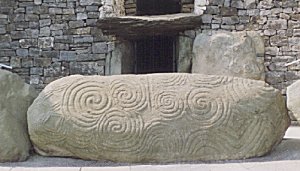
echoes of Atlantis to mediaeval death roads in 25 years
What do you do with the ley system when it has been discredited with such a hammering? Same as you do with any other goods past their sell-by date - you either dump it, or you dress it up as something else and have another go at selling it. There's probably a cultural message in how the network of power/ancient wisdom imagery from the late Sixties white heat of technology became death roads in the 1990s, and along the way ley lines lost the requirement for the straightness that had been one of their key characteristics.
The editorship of the Ley Hunter transferred to Danny Sullivan in 1996, who followed previous editor Paul Devereux's approach to the lines of energy/dowsing approach . In 1996 Devereux published a book transforming leys into straight line tracks along which corpses/spirits travelled.
In this Devereux and Sullivan should be congratulated for having the courage to knock the popular ley system on the head in the face of mounting evidence it was not founded soundly. However, it appears to me that one lot of unsatisfactory thinking was replaced by another. I was disturbed already by the Preface of Devereux's book (page 11, Shamanism And the Mystery Lines) -
"...I took over as editor of The Ley Hunter. As the editor of any specialist journal tends to do, I assembled over the years the kind of specialised library few people can afford, and became informed in certain relevant topics. As editor, one meets the researchers, the people who are actually doing things in the subject area; one constantly receives news of the latest developments. One becomes informed in a way that is not otherwise easily possible"
This seemed a curious attempt to forestall any critique of the material with a claim of a level of knowledge that would be impossible to achieve other than having been the editor of "The Ley Hunter" 1976-1996. Traditionally, a hypothesis should stand or fall on its own merits, rather than needing to be bathed in the authoritative light of its author - a line reinforced a couple of paragraphs later.
"The concepts worked through in this book, therefore, come from an informed author who has paid his dues. There are, alas, no university chairs in ley research, or alignment studies as I would prefer to call it, and many people write on the subject who are frankly, insufficiently informed or who are simply peddling a pet notion"
Conflating examples around Europe and South America such as the Nazca Lines of Peru with linear alignments in Europe came across as dodgy to me, and the leap to a universal shamanic experience did not leave me convinced at all. Allusions to the requirements for straight paths for the dead are stated, backed up by citation of mainly secondary sources. It is particularly curious that not a single one of the British burial paths cited by Sullivan in Ley Lines (a comprehensive guide to alignments) is a straight line!
This is now apparently the reason why churches are so often found on leys - little to do with prehistoric Man, everything to do with historic funerary tradition. Given the large corpus of ecclesiastical written records that we still have, I would have thought this theory would find written confirmation in descriptions of how to conduct the last rites and bury the dead from the mediaeval period, but I have not seen any British sources quoted. Alternatively, some decently straight British burial paths which would pass muster as Watkins-style ley lines would also help the hypothesis no end.
According to this proposal (summarised in Ley Lines: dead and buried), "the link we have been looking for is spirit travel - most graphically evident in the universal shamanic out of the body experience". This is apparently due to "Neurologically, the straightness comes from the entoptic nature of the out-of-the-body or near death experience." A case somewhat weakened by the next sentence "Spirals, zigzags, lines, lattices and the tunnel motif are commonly seen also" - which leads me to wonder if history is repeating itself. Where once we plucked straight lines from dots on maps we now pluck them from a number of other most definitely non-straight aspects of the near-death experience.

The time frame from which evidence is drawn also slides uneasily across the millennia as well as the continents - much is made of shamanic experience, which certainly may have been a feature of prehistoric life. Unfortunately, one of the more common motifs also attributed to shamanic trances states is the spiral - such as in the above kerbstone at Newgrange. Shamanism just doesn't fit right with mediaeval British Christian practices, so the siting of churches on straight lines derived from shamanic out of the body experiences would seem to be highly out of order.
That isn't to say that other ancient societies such as the Nazca didn't site their shrines along straight-line alignments. However, to explain straight alignments in the British landscape, we should start from a British perspective, rather than ones from the New World. We might then enlarge our lines of enquiry to other European sources - where there may be some evidence for straight-line corpse roads, unfortunately not replicated in the British landscape. Invoking South American practice to explain alignments created in England before the time of Columbus may add the spice of exotic interest to a book, but a leap so far in space and time without extraordinary evidence to support the connection is a leap too far for me.
Sometimes a lovely theory/dream/worldview turns out to be wrong. As Sullivan states at the end of Ley Lines: dead and buried
"It is time to bury the ley"